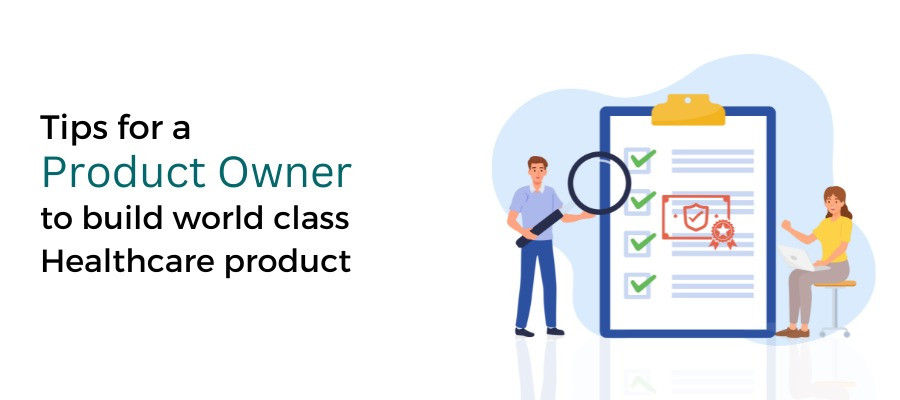Tips For A Product Owner To Build A World Class Healthcare Product

Do you know that 35% of healthcare products fail during development? The role of a Product Owner is pivotal in ensuring the successful development of healthcare products. As the Product Owner, if you are creating a world-class product, you certainly will not want to fail. Isn’t it?
So, how can you successfully build a top-notch healthcare product? First, understand that you, as the Product Owner, are a key player in Agile product development. You must guide the Agile Team with a clear Product Vision. Next, you must know how to ensure a smooth development process. If you need help with that, explore the essential tips to excel in building healthcare products that meet the end-user demands!
Who Are The Customers For Healthcare Products?
The customers for healthcare products span a wide spectrum. It includes patients, healthcare providers, administrators, insurance companies, and other regulatory bodies. As the Agile Leader, you must understand the diverse needs and expectations of these stakeholders. It is a fundamental aspect of creating a healthcare product that the customers need.
Follow The Step-by-Step Guide For Healthcare Product Development:
Once you finalize the Product Goal with a clear Product Vision, it’s time to guide the Agile Developers and other teams to complete a successful Product Development. You can inspire the teams to follow the following product development steps:
Define the Problem: Begin by identifying a pressing healthcare issue that your product can address. This step sets the foundation for your product's purpose.
Market Research: Extensive research is crucial to understanding the competitive landscape and identifying gaps in existing solutions.
User-Centered Design: Healthcare products must prioritize user-friendliness and accessibility. Engage in user-centered design to ensure a seamless user experience.
Compliance and Regulations: Given the highly regulated nature of healthcare, staying updated with industry standards and compliance requirements is non-negotiable.
Cross-Functional Teams: As a Product Owner, collaborate closely with developers, designers, and other stakeholders. In Agile and Scrum, the Scrum Team's collective efforts are essential for success.
Backlog Management: Create and prioritize the Product Backlog, ensuring that features align with the product's vision and user needs.
Sprint Planning: Use the Scrum framework for efficient Sprint planning and execution, breaking down work into manageable chunks.
Testing and Validation: Rigorous testing, including user acceptance testing, is vital in healthcare product development to guarantee safety and effectiveness.
Regulatory Approval: Navigate the complexities of obtaining regulatory approvals and certifications required for healthcare products.
Release and Iteration: Continuously iterate and improve the product based on user feedback and changing industry dynamics.
Key Roles and Responsibilities For Healthcare Product Owners:
In the Agile world, Product Owners have clear sets of roles and responsibilities. The Product Owner must fulfill the following responsibilities:
Defining and prioritizing the Product Backlog: The Product Owner ensures that the most valuable features are at the top of the backlog and ready for development.
Creating User Stories: User Stories, defined by the Product Owner, guide the developers in building features that meet user needs.
Write Acceptance Criteria: Clearly define the acceptance criteria for each User Story, providing developers with a clear understanding of what's expected.
Stakeholder Communication: Act as the bridge between stakeholders, the Scrum Team, and other teams within the organization.
Validation and Testing: The Product Owner participates in user acceptance testing to validate that the product aligns with user expectations.
What Makes You A Successful Healthcare Product Owner?
Being a successful healthcare Product Owner requires a unique blend of skills and qualities. As an Agile Practitioner, you must have the following qualities that can help you become a successful Product Owner.
Healthcare Domain Knowledge: A deep understanding of healthcare regulations, processes, and challenges is crucial.
Agile Expertise: Attaining certifications such as Certified Scrum Product Owner (CSPO) from certification organizations like Scrum Alliance delivered through PremierAgile can enhance your Agile knowledge.
Communication Skills: The product Owner must communicate with both technical and non-technical stakeholders.
Prioritization Abilities: Prioritize features based on user needs, market demands, and regulatory requirements.
Empathy For Team Members: Understand the pain points of healthcare professionals and patients to design solutions that genuinely address their concerns.
Adaptability: Be open to change and willing to adjust priorities as market dynamics evolve.
Leadership: Inspire and lead the Scrum Team towards achieving the product's goals.
Problem-Solving: Ability to tackle complex challenges in healthcare product development.
Key Takeaways For You:
Healthcare product development is the same as any type of software/product development. However, the success factor hinges on the Product Owner's ability to navigate the Agile landscape effectively. To recap the previously-discussed topics, here are the key takeaways.
- Understand your diverse customer base. Recognize that healthcare product customers include stakeholders, patients, and regulators.
- Follow a structured approach to healthcare product development. Begin with a problem definition and end with Continuous Iteration.
- Embrace your role and grasp your key responsibilities as a Product Owner. Perform Backlog Management and Acceptance Testing.
- Invest in healthcare domain knowledge to enhance your Agile Coach expertise and communication skills.
- Be adaptable, empathetic, and a problem-solver to excel in the dynamic healthcare landscape.
Building world-class healthcare products as a Product Owner requires a combination of domain expertise and Agile proficiency. By following these tips and embracing the Agile mindset, you can play a pivotal role in shaping the future of healthcare through innovative and impactful products.
Reference:
https://www.linkedin.com/pulse/10-product-design-tips-healthcare-leaders-riken-shah/




